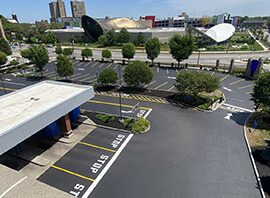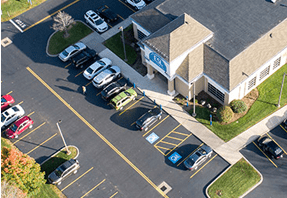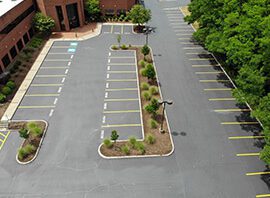Mar 26, 2025 | 1-800-Striper NE Boston
Eco-friendly striping has become a game-changing approach in construction and renovation projects. This innovative practice uses sustainable materials and environmentally conscious techniques to create markings, designs, and surface treatments while minimizing ecological impact.
The demand for green alternatives has skyrocketed as property owners, contractors, and designers recognize the critical need to reduce their environmental footprint. Traditional striping methods often rely on harsh chemicals and materials that can harm both human health and the environment. By adopting eco-friendly striping practices, you can:
This comprehensive guide will walk you through the most effective sustainable striping techniques, from natural paint strippers to innovative infrared technology. You’ll discover practical ways to implement these methods in your projects while maintaining professional results. Get ready to transform your approach to striping – your planet will thank you.
Traditional striping methods have a significant impact on the environment, which requires immediate action. Chemical-based strippers release Volatile Organic Compounds (VOCs) into the air, causing air pollution and potential health risks for workers and building occupants.
Environmental Impact of Conventional Striping Methods
The environmental impact of conventional striping methods includes:
Health Risks for Workers
Workers exposed to traditional chemical strippers face serious health risks:
The construction industry has seen a 15% annual increase in demand for eco-friendly striping alternatives since 2020. This shift reflects the growing awareness of environmental sustainability and stricter regulations on chemical usage in construction projects.
Recent studies show that buildings using traditional striping methods can have elevated levels of toxic compounds for up to six months after application. These findings have led many property developers and contractors to look for safer alternatives that protect both the environment and human health.
The market response to these concerns has driven innovation in sustainable striping technologies. Green building certifications now award additional points for projects utilizing eco-friendly striping methods, pushing the industry toward more sustainable practices.
The shift toward eco-conscious practices has changed the way we remove paint, introducing new methods that are good for both your health and the environment. Let’s take a look at these sustainable approaches, starting with natural-based strippers.
Natural-based paint strippers are a significant advancement in eco-friendly paint removal technology. These products use plant-derived compounds to break down paint effectively without harsh chemicals.
Key Benefits of Natural-Based Strippers:
Performance Comparison:
Natural strippers have proven highly effective against multiple paint layers:
Indoor Safety Considerations:
When using natural strippers indoors, follow these essential practices:
○ Chemical-resistant gloves
○ Safety goggles
○ Long-sleeved clothing
Application Tips:
These natural alternatives show that effective paint stripping doesn’t need harsh chemicals. Their growing popularity comes from their ability to deliver professional results while being environmentally friendly.
Heat guns offer a chemical-free approach to paint removal, making them an excellent choice for eco-conscious projects. These tools work by directing concentrated hot air onto painted surfaces, causing the paint to soften and bubble. You can then easily scrape away the loosened paint using a putty knife or scraper.
Key Benefits of Heat Gun Paint Removal:
Heat guns prove particularly effective on flat surfaces and detailed trim work. The method excels at removing multiple paint layers without damaging the underlying material, provided you maintain proper temperature control and technique.
Sanding is a mechanical method of removing paint that doesn’t involve any chemicals. It uses abrasive materials to physically scrape off the layers of paint, making it an environmentally friendly option for your stripping projects.
Essential Grit Selection Guide:
The sanding process creates fine dust particles rather than chemical waste, requiring proper protective equipment:
Pro Tips for Effective Sanding:
Electric sanders can speed up larger projects while maintaining eco-friendly benefits. Options include:
The dust collection system on power sanders helps maintain a clean workspace and enables proper disposal of paint particles. This method proves particularly effective for wooden surfaces and delivers excellent results when preparing surfaces for new finishes.
Infrared paint removal is an advanced method used in eco-friendly striping practices. This cutting-edge technology utilizes infrared radiation to directly heat paint layers, causing them to detach from the underlying surface without harming the base material.
How It Works
The process involves emitting controlled infrared waves that penetrate the paint surface and heat it from within. As the paint reaches specific temperatures, it softens and bubbles, making it easy to scrape off with minimal effort. The precision of infrared technology allows for targeted removal without affecting surrounding areas.
Key Benefits of Infrared Paint Removal:
The technology shows promising developments in commercial applications. Recent advancements include:
Research indicates that infrared paint removal could reduce project completion times by up to 60% compared to traditional methods. The efficiency of this technology, combined with its minimal impact on the environment, positions it as a leading solution in eco-friendly striping practices.
Furthermore, a 2018 report highlighted various environmental security measures related to such innovative technologies, emphasizing their potential in sustainable practices.
Safety Note: Always wear appropriate protective gear and ensure proper ventilation when using infrared paint removal equipment.
Responsible waste management is essential for any eco-friendly striping project. Paint stripping produces various waste materials that need to be handled properly to protect our environment.
Common Waste Materials in Striping Projects:
Safe Collection and Containment
You must collect waste materials in sealed, heavy-duty containers labeled with their contents. Keep different types of waste separate – hazardous materials should never be mixed with non-hazardous waste.
Recycling Options
Many materials from striping projects can be recycled:
Hazardous Waste Handling
Paint residue containing lead or other toxic substances requires special attention:
Water Management
Proper water management prevents contamination:
Local regulations often dictate specific requirements for waste disposal in striping projects. You’ll need to check with your area’s environmental protection agency for detailed guidelines. Many municipalities offer special collection days for construction-related waste materials.
Aluminum strip ceilings are an important development in energy-efficient materials in construction projects. These innovative ceiling systems offer significant environmental advantages while still being visually appealing and functional.
Key Benefits of Aluminum Strip Ceilings:
The lightweight nature of aluminum strip ceilings reduces structural load requirements, enabling more efficient building designs. These systems also contribute to improved indoor air quality by preventing the accumulation of dust and allergens.
Installation Advantages:
Aluminum strip ceilings integrate seamlessly with modern HVAC systems, supporting energy-efficient climate control. Their modular design allows for easy replacement of individual panels, reducing maintenance waste and supporting long-term sustainability goals.
The shift toward eco-friendly striping practices represents a crucial step in building a sustainable future. Your choice to adopt these environmentally conscious methods creates ripple effects that extend far beyond individual projects. By selecting natural stripping solutions, implementing proper waste management, and choosing sustainable materials like aluminum strip ceilings, you’re actively contributing to:
The future of eco-friendly striping looks promising, with continuous innovations in sustainable technologies and materials. Each environmentally conscious decision you make today shapes the construction industry of tomorrow. Your commitment to green practices not only protects our planet but also inspires others to follow suit. The path to a greener future starts with the choices

Had our parking lot paved and found ourselves needing lines. Their team was fantastic from start to finish. They took the time to give great advice and listened closely to our company’s needs.

They are very responsive and complete the work in a timely fashion. I have used them for 18 years and have never had any issue with their work. Very highly recommended.

They are very easy to work with and have a highest level of attention to detail. They are very knowledgeable and passionate about parking lot striping. Their quality of work is outstanding!
COPYRIGHT © 1999-2025 | ALL RIGHTS RESERVED STRIPER INDUSTRIES, INC. | Privacy Policy | Powered by Bon's Eye Marketing